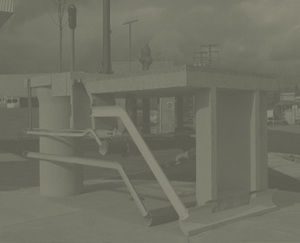Russell Keziere
Vanguard, Vol. 9 #1, February 1980.
This year's Vancouver Island Invitational at the Art Gallery of Greater Victoria concerns itself with the work of four sculptors. It consists of five very small bronze pieces by Victoria resident Elza Mayhew; three maquettes for a work completed in California by the University of Victoria teacher Mowry Baden; two large wood, metal and plastic tube constructions by the St. Martin's graduate and Hornby Islander Tom Burrows; and two, even larger, wood, metal and glass structures by former AGGV Curator of Contemporary Art, Greg Snider.
I have listed the artists in a reverse order of preference, vis a vis this exhibition. Mayhew's tiny little bronze paperweights resemble studies for larger works. The largest of the five is Sphinx, which has bilateral and Brancusi-like undulating curves. It has a rather emphatic aperture in its middle, however, and one cannot help but surmise that this is the orifice through which the oracle of the Sphinx will come to us. The references to symbolism are overt and do not relate at all well to the work of the other three sculptors. Little Temple demonstrates this best of all: it is a little bronze box with a tiny doorway through which we can see a crude goddess figure on the inside back wall of the box, waiting for our offerings.
Mayhew's work in this exhibition is diminutive and not simply miniature. One can make too much of bigness, of course, especially with precedents set by Joel Shapiro, Charles Symonds, or Vancouver's Al MacWilliams, for small but powerful sculptures. But when we compare these works of Mayhew's to her free standing column outside the McPherson Library at the University of Victoria, one cannot help but be disappointed by their unambitious character. To her credit, however, she did come up with some original art. Mowry Baden did not do even this. His contribution was some paltry documentation of a work he completed last summer, a site installation in Davis, California called Wild Celery for Stephen Davis. Judging from the photographs and the maquettes, this piece looks like an interesting project. Baden constructed a series of red painted steel mesh walkways that crisscross over a small creek bed. One is guided along these paths and must, I would imagine, keep one's eyes on the ground to avoid falling off. The sculpture would appear to be about an experience of space which is more physical than visual, combined with a use of the natural contours and colours of the landscape. It would appear also to have the additional merit of a possible long distance perspective: red lines against the grass. It looks like this might be the case; I cannot really tell, not having seen it. All Baden has given us in Victoria is conjecture, a few photographs and three sample maquettes, none of which were used in the final plan. This is a pity. Baden's position as a teacher of sculpture at the University is one which should have precluded such a nominal contribution.
Tom Burrows's work interests me less than Baden's, but it, at least, was there in the flesh. Both of his works are untitled, and while they were intended for an exterior location, one is found inside the gallery.
The interior work is a large metal circle intersected by two verticals, one wood and one plastic. The verticals are clamped to the circle with large C-clamps. In spite of the clamps, it looks like you could kick one of the verticals out and bring the whole thing down. Caroesque use of balancing and industrial materials is fine, mostly for Caro, but the work should have some integrity. As it stands it looks like a casual and randomly formed construction.
The exterior work has the same problem. It consists of three long, shaved arbutus poles, buttressed at the bottom with three small cement wedges and propped up into a teepee. A long plastic pipe rises from the apex, the same type of pipe found inside. It too has the effect of being thrown together, without being inspiring in its random arbitrariness. The components could be reshuffled ad infinitum without detracting from the original thought, which is a statement on the lack of thought and not its versatility.
Greg Snider also uses industrially available materials, but to different advantage. The two pieces in this exhibition, one inside the gallery space and the other outside, are integrated both formally and structurally. The outside work is a large unit of two facing triangles made up of cedar beams and held in balance by thick steel chains. The lines of the chains form another set of triangles and when the wood and steel are taken together the result is a single geometric unit which resembles a mixed-media trapezoid. The work, completed in 1978, is titled simply Two X Four. While one may question his choice of materials, the strength of line and balance is manifest.
The most intriguing work in the exhibit is Double Cross / Double Bind, The title is appropriately descriptive of both the method of construction and its psychological effect.
Snider has taken four large beams soaked in creosote and flecked with graphite, which are crossed to form two Xs. Between these two Xs, which are bolted together, are sandwiched two large tractor inner tubes which are naturally flecked with graphite. And between the two inflated inner tubes is a large square sheet of industrial safety glass, with the wire grid in it to prevent shattering. This square is set off by 45° so that one of the corners is poised directly above the floor, clearing it by about five inches.
The first thing that comes clear from this work is that if someone were to come along and deflate the inner tubes or slash them with an exacto knife, the glass would drop, leaving a permanent hole in the nice Art Gallery of Greater Victoria floor.
This tension and pressure, without wishing to overemphasize the drama, tightens the formal integrity of the work. We would be 'double crossing' the glass by deflating the inner tubes, which leaves us in a 'double bind'. The components of this work, unlike the Burrows, are in a state of polarized and unified coexistence. The rawness and the found quality of the material is used stylistically, as is demonstrated by the use of graphite in the black creosote beams. The flecking which results relates to the flecking on the inner tubes. The sword of Damocles is writ here in stylized industrial terms.
This exhibition of four sculptors should have been reduced to two. Tom Burrows and Greg Snider should have been given the space between them and should have been allowed to contribute another three works each. But for their contribution the exhibition would have been a non-event.
Vanguard, Vol. 9 #1, February 1980.
Text: © Russell Keziere. All rights reserved.
The Centre for Contemporary Canadian Art
The Canadian Art Database: Canadian Writers Files





All Rights Reserved. contact: greg@gregsnider.ca
Mowry Baden, Tom Burrows, Elsa Mayhew & Greg SniderArt Gallery of Greater Victoria, November 28 - January 6, 1979-80
gregsnider.ca Copyright © 2007 - Greg Snider.